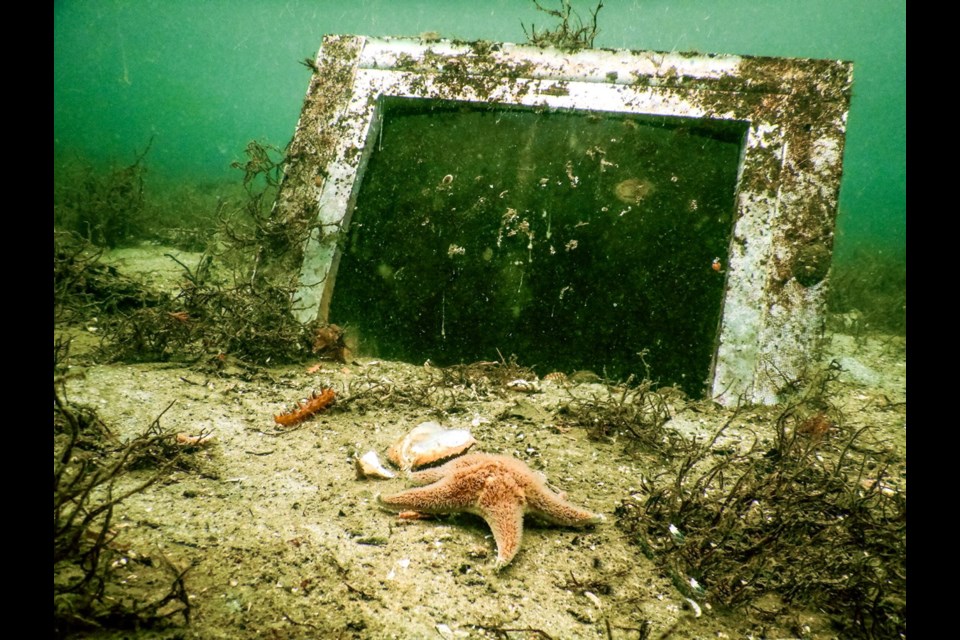The more than 20 tonnes of marine debris a Victoria-based non-profit has collected from the floor of the Salish Sea includes the proverbial kitchen sink.
The sink was pulled out of Porpoise Bay as part of a Sechelt Inlet debris-removal project in November 2018. It’s just one of many pieces of household trash the SeaChange Marine Conservation Society has hauled out of shallow waters in the past two years, including a clothes washer, chairs and a sewing machine.
The garbage removal is part of the society’s Salish Sea Nearshore Habitat Recovery Project, a five-year program to clean up the debris and restore shallow marine habitat on the Canadian side of the Salish Sea. The program began in 2017 and is set to run until 2022.
Their efforts centre around eelgrass (Zostera marina), a perennial flowering marine plant that once flourished in underwater meadows found in the shallow estuaries and bays of the Salish Sea.
The plant provides important habitat for migrating salmon and spawning grounds for Pacific herring. The eelgrass ecosystem is also vital for crabs and other marine life. The plant reproduces by sending new shoots as its thick roots (the rhizome) grow. Plants flower in late spring, with seeds drifting with the currents.
The region’s Indigenous Peoples, including the Salish, Nuu-chah-nulth, Kwakwaka’wakw and Haida, usually harvested the rhizomes and leaf bases around May, gathering them at low tide from canoes. The plant, described as crisp, sweet and salty, was used to flavour meat, eaten dipped in ooligan grease or made into cakes and dried for the winter.
A second harvest occurred after spawning herring deposited their eggs on the eelgrass. The eggs were either eaten while still attached to the plant or removed and eaten separately.
Aside from dumping of trash in the ocean, eelgrass habitat is under threat from everything from shoreline development to shading from docks, scouring by anchor chains, marine pollution, nutrient runoff from farms, failing septic systems, stormwater runoff and flushing of boat sewage — not to mention global warming and rising sea levels.
“Removing kitchen sinks and generators from the seabed can be rewarding in the moment, but inevitably the dive crew becomes despondent as humans have collectively been treating the ocean as a toxic waste dump for over a century,” said Nikki Wright, executive director for SeaChange.
Once the garbage has been removed, SeaChange begins some underwater gardening — transplanting eelgrass shoots harvested from healthy colonies into areas where debris has been removed, or filling in gaps in existing eelgrass beds.
Two eelgrass-habitat restorations have already taken place on the Gulf Islands: Clam Bay on Thetis Island and Medicine Beach on Pender Island.
The plan was for divers to clear the waters off Lasqueti Island, Indian Arm in Burrard Inlet and Howe Sound this spring, although those cleanup efforts have been put on hold during the COVID-19 outbreak, said project manager Maria Catanzaro.
When they’re established, the restored meadows improve water quality and stabilize shorelines by settling sediment that is suspended in the water — particles of sediment settle to the bottom when they reach the eelgrass bed, making the water clearer.
Part of the initiative involves educating and engaging the community so it does less harm to the marine environment, Catanzaro said.
“It’s about changing behaviour,” she said. “By and large, people want to make good decisions and be stewards of the ocean. They just need guidance on best practices.”
Catanzaro said a good start would be for boaters to use environmentally friendly mooring systems — ones that prevent bottom-chain scouring of sensitive sea beds — and not to anchor near eelgrass habitats.
A similar awareness program initiated in Port Townsend, Washington, has seen 98 per cent compliance by boaters, she said. “Our goal is not only to protect and restore these habitats, but to restore people’s connection to the natural world and nurture a sense of community-based stewardship.”
The project is funded by Fisheries and Ocean Canada as part of its Coastal Restoration Fund. The Pacific Salmon Foundation has contributed additional funding, with the District of Sechelt offering donated dock space, trucks for debris transport and labour. The Sunshine Coast Regional District has waived landfill fees for collected debris that cannot be recycled.
Local communities also come together to help lend a hand on days when restoration work is being done. For more information or to volunteer, go to seachangesociety.com.



